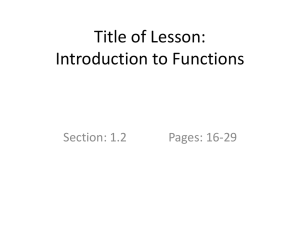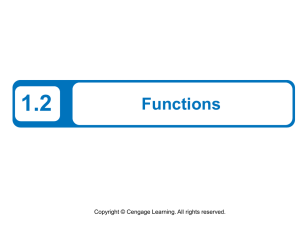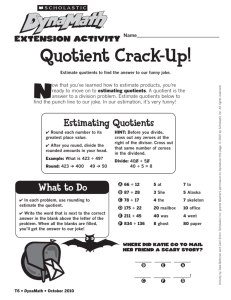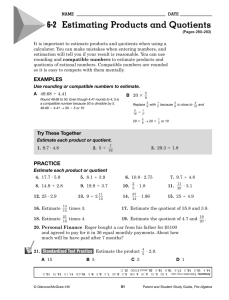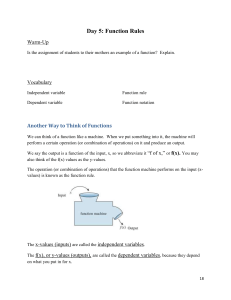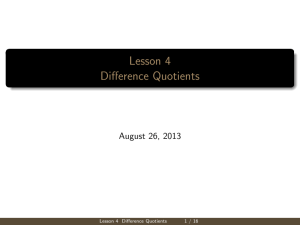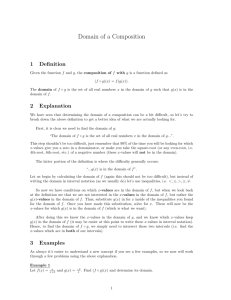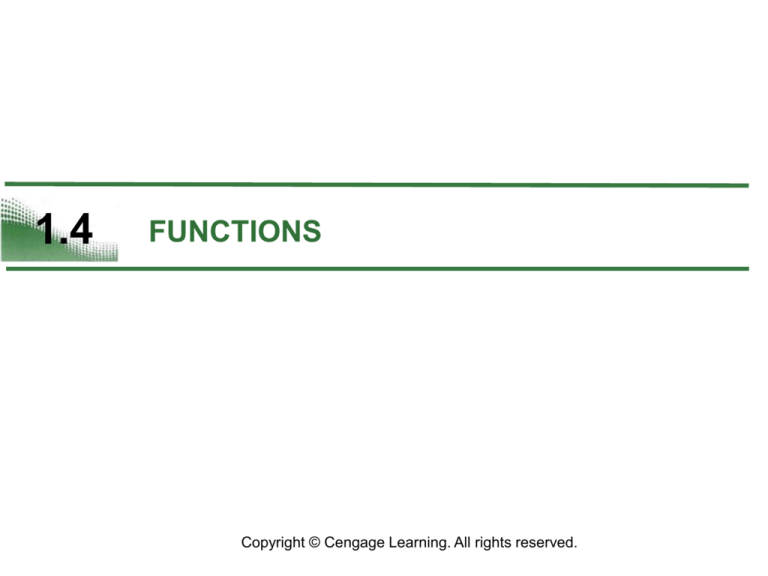
1.4
FUNCTIONS
Copyright © Cengage Learning. All rights reserved.
What You Should Learn
• Determine whether relations between two
variables are functions.
• Use function notation and evaluate functions.
• Find the domains of functions.
• Use functions to model and solve real-life
problems.
• Evaluate difference quotients.
2
Introduction to Functions
3
Introduction to Functions
In mathematics, relations are often represented by
mathematical equations and formulas.
For instance, the simple interest I earned on $1000 for
1 year is related to the annual interest rate r by the
formula
I = 1000r.
4
Introduction to Functions
5
Introduction to Functions
Set A is the domain.
Inputs: 1, 2, 3, 4, 5, 6
Set B contains the range.
Outputs: 9, 10, 12, 13, 15
6
Introduction to Functions
{(1, 9), (2, 13), (3, 15), (4, 15), (5, 12), (6, 10)}
7
Introduction to Functions
8
Example 1 – Testing for Functions
Determine whether the relation represents y as a function
of x.
a. The input value x is the number of representatives from
a state, and the output value y is the number of senators.
b.
c.
Figure 1.48
9
Example 1 – Solution
a. This verbal description does describe y as a function of x.
Regardless of the value of x, the value of y is always 2.
Such functions are called constant functions.
b. This table does not describe y as a function of x. The
input value 2 is matched with two different y-values.
10
Introduction to Functions
c. The graph in Figure 1.48 does describe y as a function
of x. Each input value is matched with exactly one output
value.
y = x2
y is a function of x.
represents the variable y as a function of the variable x.
x - the independent variable
y - the dependent variable.
11
Introduction to Functions
Domain of the function: the set of all values taken on by
the independent variable x,
Range of the function: the set of all values taken on by the
dependent variable y.
12
Function Notation
13
Function Notation
Input
x
0
−1
3
𝑥+ℎ
Output
f (x)
Equation
f (x) = 1 – x2
𝑓(0)
𝑓 0 = 1 − 02 = 1
𝑓(−1)
𝑓 −1 = 1 − (−1)2 = 0
𝑓(3)
𝑓 3 = 1 − 32 = −9
𝑓(𝑥 + ℎ)
𝑓 𝑥 + ℎ = 1 − (x + h)2
14
Function Notation
f (x) = x2 – 4x + 7
f (t) = t2 – 4t + 7
g(s) = s2 – 4s + 7
15
Function Notation
piecewise-defined function : a function defined by two or
more equations over a specified domain.
16
Example 4 – A Piecewise-Defined Function
Evaluate the function when x = –1, 0, and 1.
Solution:
Because x = –1 is less than 0, use f (x) = x2 + 1 to obtain
f (–1) = (–1)2 + 1
= 2.
For x = 0, use f (x) = x – 1 to obtain
f (0) = (0) – 1
= –1.
17
Example 4 – Solution
cont’d
For x = 1, use f (x) = x – 1 to obtain
f (1) = (1) – 1
= 0.
18
The Domain of a Function
19
The Domain of a Function
Implied domain: the set of all real numbers for which the
expression is defined.
Domain excludes x-values that result
in division by zero.
has an implied domain that consists of all real x other than
x = ±2.
20
The Domain of a Function
Domain excludes x-values that result
in even roots of negative numbers.
is defined only for x 0. So, its implied domain is the interval
[0, ).
21
Example 7 – Finding the Domain of a Function
Find the domain of each function.
a. f : {(–3, 0), (–1, 4), (0, 2), (2, 2), (4, –1)}
b.
c. Volume of a sphere:
d.
22
Example 7 – Solution
a. The domain of f consists of all first coordinates in the set
of ordered pairs.
Domain = {–3, –1, 0, 2, 4}
b. Excluding x-values that yield zero in the denominator, the
domain of g is the set of all real numbers x except x = –5.
c. Because this function represents the volume of a sphere,
the values of the radius r must be positive.
So, the domain is the set of all real numbers r such that
r > 0.
23
Example 7 – Solution
cont’d
d. This function is defined only for x-values for which
4 – 3x 0.
By solving this inequality, you can conclude that
So, the domain is the interval
24
The Domain of a Function
Domain: (0, +∞)
25
Applications
26
Example 8 – The Dimensions of a Container
You work in the marketing department of a soft-drink
company and are experimenting with a new can for iced
tea that is slightly narrower and taller than a standard can.
For your experimental can, the ratio of the height to the
radius is 4, as shown in figure.
a. Write the volume of the can
as a function of the radius r.
b. Write the volume of the can as
a function of the height h.
27
Example 8 – Solution
a. V (r) = r 2h
Write V as a function of r.
= r 2(4r)
= 4 r 3
b.
Write V as a function of h.
28
Difference Quotients
29
Difference Quotients
Difference Quotient
30
Example 11 – Evaluating a Difference Quotient
For f (x) = x2 – 4x + 7, find
Solution:
31
Difference Quotients
32
Difference Quotients
33

